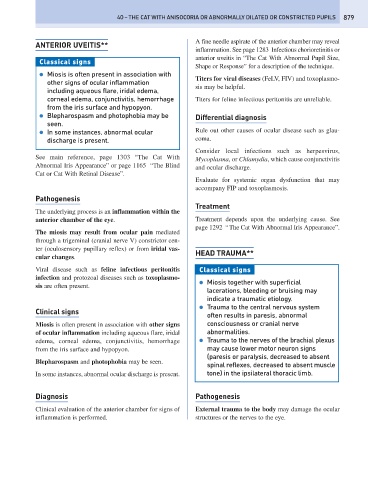Page 887 - Problem-Based Feline Medicine
P. 887
40 – THE CAT WITH ANISOCORIA OR ABNORMALLY DILATED OR CONSTRICTED PUPILS 879
A fine needle aspirate of the anterior chamber may reveal
ANTERIOR UVEITIS**
inflammation. See page 1283 Infectious chorioretinitis or
anterior uveitis in “The Cat With Abnormal Pupil Size,
Classical signs
Shape or Response” for a description of the technique.
● Miosis is often present in association with
Titers for viral diseases (FeLV, FIV) and toxoplasmo-
other signs of ocular inflammation
sis may be helpful.
including aqueous flare, iridal edema,
corneal edema, conjunctivitis, hemorrhage Titers for feline infectious peritonitis are unreliable.
from the iris surface and hypopyon.
● Blepharospasm and photophobia may be Differential diagnosis
seen.
● In some instances, abnormal ocular Rule out other causes of ocular disease such as glau-
discharge is present. coma.
Consider local infections such as herpesvirus,
See main reference, page 1303 “The Cat With Mycoplasma, or Chlamydia, which cause conjunctivitis
Abnormal Iris Appearance” or page 1165 “The Blind and ocular discharge.
Cat or Cat With Retinal Disease”.
Evaluate for systemic organ dysfunction that may
accompany FIP and toxoplasmosis.
Pathogenesis
Treatment
The underlying process is an inflammation within the
anterior chamber of the eye. Treatment depends upon the underlying cause. See
page 1292 “The Cat With Abnormal Iris Appearance”.
The miosis may result from ocular pain mediated
through a trigeminal (cranial nerve V) constrictor cen-
ter (oculosensory pupillary reflex) or from iridal vas-
HEAD TRAUMA**
cular changes.
Viral disease such as feline infectious peritonitis Classical signs
infection and protozoal diseases such as toxoplasmo-
● Miosis together with superficial
sis are often present.
lacerations, bleeding or bruising may
indicate a traumatic etiology.
● Trauma to the central nervous system
Clinical signs
often results in paresis, abnormal
Miosis is often present in association with other signs consciousness or cranial nerve
of ocular inflammation including aqueous flare, iridal abnormalities.
edema, corneal edema, conjunctivitis, hemorrhage ● Trauma to the nerves of the brachial plexus
from the iris surface and hypopyon. may cause lower motor neuron signs
(paresis or paralysis, decreased to absent
Blepharospasm and photophobia may be seen.
spinal reflexes, decreased to absent muscle
In some instances, abnormal ocular discharge is present. tone) in the ipsilateral thoracic limb.
Diagnosis Pathogenesis
Clinical evaluation of the anterior chamber for signs of External trauma to the body may damage the ocular
inflammation is performed. structures or the nerves to the eye.

